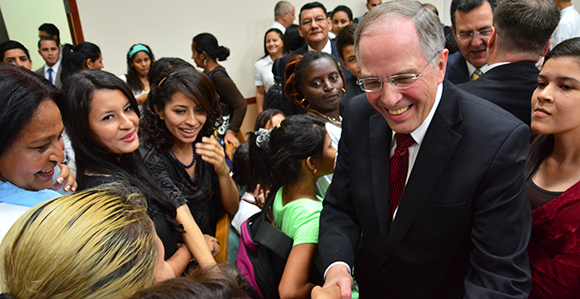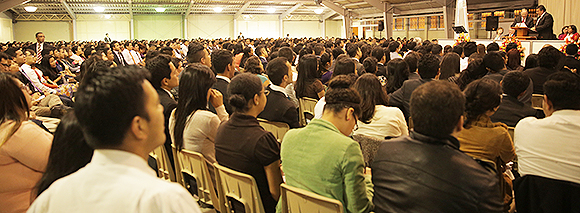Central American Saints Finding Spiritual Safety in the Gospel
Contributed By Jason Swensen, Church News staff writer

Elder Neil L. Andersen greets youth in Honduras during his March 2015 visit to Central America.
“Our meetings were blessed by a powerful, heavenly spirit as we confirmed each person’ s importance to his or her Father in Heaven and as we witnessed the loving power of the Atonement of the Savior.” —Elder Neil L. Andersen of the Quorum of the Twelve
The Book of Mormon offers a remarkable gospel promise for the people of Central America:
“And at that day shall the remnant of our seed know that they are of the house of Israel, and that they are the covenant people of the Lord; and then shall they know and come to the knowledge of their forefathers, and also to the knowledge of their Redeemer, which was ministered unto their fathers by him; wherefore, they shall come to the knowledge of their Redeemer and the very points of his doctrine, that they may know how to come unto him and be saved” (1 Nephi 15:14).
The realization of “that day,” said Elder Neil L. Andersen of the Quorum of the Twelve Apostles, can be witnessed across the nations of Central America.
“You can feel the strength coming from the children of Lehi there,” said Elder Andersen. “You see it in the people’s faces and in their answers to our questions.”
The Apostle spoke with the Church News following his recent visit to that Latter-day Saint-rich region of Latin America to preside over a review of the Central America Area.
Elder Richard J. Maynes of the Presidency of the Seventy and Bishop Dean M. Davies, Second Counselor in the Presiding Bishopric, also participated in the annual review.

From left, Elder Kevin R. Duncan, Bishop Dean M. Davies, Elder Richard J. Maynes, and Elder Neil L. Andersen greet members at the conclusion of a priesthood leadership conference in Guatemala City, Guatemala. Photo courtesy of the Central America Area.
Besides conducting the review at area headquarters in Guatemala City, Guatemala, the visiting Brethren presided over a variety of meetings for members, missionaries, local priesthood leaders, and young single adults in several Central American cities.
Elder Andersen, Elder Maynes, and Bishop Davies were together at some of the meetings and then separated for other gatherings to visit as many regions as possible.
Elder Andersen’s time in Central America included visits to Honduras and Guatemala. Besides visits to those nations, Elder Maynes’s itinerary also included meetings in Costa Rica, while Bishop Davies presided over gatherings in Nicaragua.
Elder Maynes said that one of the highlights of the Central America visit was meeting with missionaries from eight different missions in the countries of Honduras, Guatemala, Nicaragua, and Costa Rica.
“The full-time missionaries serving in these countries come from all over the world, and they are enjoying amazing results,” he said.
Elder Maynes noted that the Central America Area has approximately 3,400 full-time missionaries who have been called from the area. “The number of missionaries serving in the area and those called from the area is almost identical, making the area self-reliant in full-time missionaries.
The Central America visit was something of a missionary reunion for Elder Maynes and Bishop Davies. The two were companions when they served their missions to Uruguay 43 years ago.
Elder Andersen said he found at each locale humble and devout members with a deep understanding of the doctrine of the Lord’s gospel.
“Their questions and the depth of their insights are all very spiritual,” he said. “They have embraced the gospel, and the gospel goes deep into their hearts.”
Many members in Central America face economic challenges in their respective homes, added Bishop Davies. “But they are rich in the things that really count.”
Like faithful Latter-day Saints across the globe, the Central American members have found “spiritual safety” in the gospel, said Elder Andersen.
Central America’s many meetinghouses offer a refuge and sanctuary from the troubles of the outside world.
“Throughout Central America, you feel a sense of well-being in the churches,” observed Bishop Davies. “I was so impressed with the reverence that we felt.”

More than 2,000 young single adults gathered for a special meeting in Guatemala City, Guatemala. Photo courtesy of the Central America Area.
At the conclusion of a young single adult meeting in Guatemala City, where a powerful spiritual feeling filled the room, the congregation of more than 2,000 people rose to their feet but did not leave their places.
Elder Andersen and the other Brethren moved to the congregation and began shaking hands. Even after being invited to leave as they needed, no one moved.
All stood reverently for the 15 minutes that the Brethren silently went from row to row shaking the hands of hundreds. The spirit in the building was magnified.
The young adults also surprised Elder Andersen and his wife, Sister Kathy Andersen, by singing an impromptu version of “Happy Birthday” in Spanish to Sister Andersen, who was commemorating a birthday.
The formal review of the Central America Area was a great success, reported Elder Andersen. The visiting Brethren met with the Area Presidency—Elder Kevin R. Duncan, Elder Adrian Ochoa, and Elder Jose L. Alonso of the Seventy—to discuss the work of the Church throughout the region—including missionary work, family history and temple work, employment and other temporal affairs matters, and the Church education programs.
The Brethren also visited sites in Central America where the Church has built a new generation of meetinghouses designed to blend naturally into their respective communities. They can be completed for significantly less than prior meetinghouse designs.

A new generation of cost-efficient, community-friendly meetinghouses such as this Church building in Nicaragua are being built in Central America. Photo courtesy of Bishop Dean M. Davies.

Elder Neil L. Andersen and other General Authorities and Church officials and their wives gather at the construction site of one of the new generation of meetinghouses in Central America. Photo courtesy of the Central America Area.
“They are buildings that are entirely functional and cost-effective and are easy to construct and maintain,” said Bishop Davies. “They beautify the community without overstating.”
Elder Andersen said the new, community-friendly meetinghouse design is another element of the Church truly becoming “a worldwide Church.”
The Church is still young in Central America. The gospel was not widely taught in any of the countries until after World War II. But in that short time, Central America has become a true power for the Church.
The Church in Central America is young “and truly a rising generation,” said Bishop Davies. Many of the young people are second- and even third-generation Latter-day Saints. Legions of returned missionaries can be found serving in the area’s 100-plus stakes.
Elder Andersen also spoke of the lasting impact the temple has made in the area. The Central America Area can truly be called a “land of temples.”
In recent years, temples were built and dedicated in Panama, Costa Rica, Honduras, El Salvador, and Guatemala.
The Apostle returned from his visit uplifted by the faith and strength of the Central American members. He is optimistic for their future.
“Our meetings were blessed by a powerful, heavenly spirit as we confirmed each person’s importance to his or her Father in Heaven and as we witnessed the loving power of the Atonement of the Savior.”
Several General Authorities participated in the recent review of the Central America Area—including Elder Neil L. Andersen of the Quorum of the Twelve Apostles, Elder Richard J. Maynes of the Presidency of the Seventy, and Bishop Dean M. Davies of the Presiding Bishopric. They were accompanied by their wives—Sister Kathy Andersen, Sister Nancy Maynes, and Sister Darla Davies.
Also participating was the Central America Area Presidency—Elder Kevin R. Duncan, Elder Adrian Ochoa, and Elder Jose L. Alonso, all of the Seventy. They were accompanied by their wives—Sister Nancy Duncan, Sister Nancy Ochoa, and Sister Rebeca Alonso.
